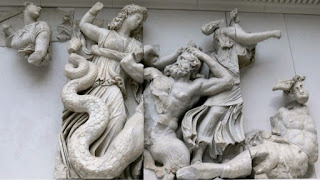 |
| The Altar of Zeus and Athena |
The Altar of Zeus
‘The Altar of Zeus and Athena’
or ‘Pergamon Altar’ which was set in the city of Pergamon, is a good example to assert that how has
Greek art been changed during the Hellenistic period. The Altar of Zeus and
Athena is a monumental construction built during the reign of King Eumenes II
in the first half of the 2nd century BC.
In the altar, a war was described between the gods and giants. However, it was a great work that shows the tension of war with its reliefs, it is not as good as previous Greek art sculptures in terms of harmony and details. Most probably, the sculpture had thought that revealing stronger and dramatic senses were more important than having a sensitive looking. The war which the altar describes, gives information about a longlasting time period. After an unmerciful war, gods are having the edge over the bulky giants, then gain a great victory. It can be seen that the relief art of this work are not low level relief and not made of plaster like Plaster Relief of Seljuks. Figurines are nearly displaced from where they have to be in. A deploying move such that makes the altar has a live view. The struggle that goes on the stairs also contributes to this live view. This kind of striking and predacious works like the Altar of Zeus or Laocoön and His Sons, were the significances of Hellenistic Period. Unfortunately, many of them have gained fame in next periods instead of the one they had been made.
What does it Depict?
 |
| Ancient Greek City Pergamon |
 |
| Figurines from the Altar |
 |
| Figurines from the Altar |
The Altar of Zeus and Athena
 Reviewed by Articonog
on
December 18, 2019
Rating:
Reviewed by Articonog
on
December 18, 2019
Rating:
 Reviewed by Articonog
on
December 18, 2019
Rating:
Reviewed by Articonog
on
December 18, 2019
Rating:





No comments: